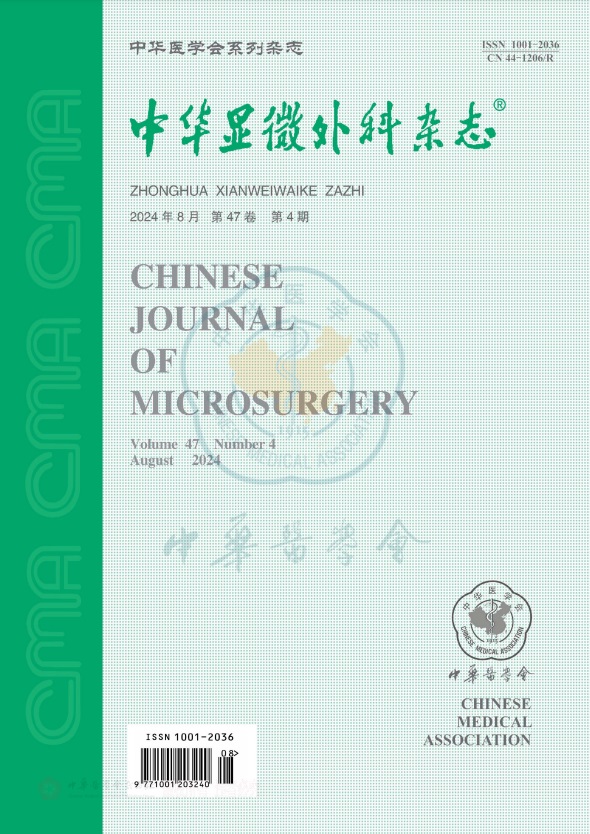The clinical outcome of Narakas II obstetric brachial plexus palsy by neurolysis and never grafting
引用次数: 0
Abstract
Objective To explore the efficacy of neurolysis or nerve grafting in the treatment of the conducting neuroma of Narakas II obstetric brachial plexus palsy (OBPP), and provide the reference basis for choosing an optimal method. Methods From January, 2009 to December, 2014, 32 patients undergoing surgical treatment due to Narakas II OBPP were included in this study. Neurolysis was performed in 15 patients, and the procedure of nerve grafting was performed in 17 patients. The general information included gender, age, birth weight, injury cause, etc. were recorded and compared to each other between 2 groups. A followed-up study had been conducting after surgery, the functional rating systems of Gilbert and Raimondi were used for quantitative comparison between preoperative function and postoperative function of shoulder joint, elbow joint and hand. In addition, the differences of the measurement data were compared with the single factor analysis of variance and paired t-test by using SPSS 22.0 statistical software. When P<0.05, it was considered statistically significant. Results There was no statistically significant difference in the baseline information between 2 groups (P>0.05). The average time of follow-up was 58.44 (48-96) months. And the fourth year' average score of shoulder joint, elbow joint, hand of the neurolysis group improved from preoperative (1.07±0.85) , (2.07±0.77) and (3.47±0.62) score to (3.00±0.73), (4.13±0.62) and (4.53±0.72) score (P 0.05), respectively. In addition, the proportion of the patients who needed the secondary operation about functional reconstruction in the neurolysis group and the nerve grafting group was 73.33% and 35.29% respectively, besides the proportion of the shoulder joint and elbow joint in the surgical sites accounted for 82.35%, 17.65% respectively. Conclusion Nerve grafting is a better choice for the treatment of conducting neuroma of Narakas II OBPP at present. Key words: Obstetric brachial plexus palsy; Neurolysis; Never grafting; NeuromaNarakas II型产科臂丛神经麻痹神经松解术的临床效果
目的探讨神经松解术或神经移植术治疗Narakas II型产科臂丛神经麻痹(OBPP)传导神经瘤的疗效,为选择最佳方法提供参考依据。方法自2009年1月至2014年12月,32例因Narakas II OBPP接受手术治疗的患者纳入本研究。神经松解术15例,神经移植术17例。记录包括性别、年龄、出生体重、受伤原因等在内的一般信息,并在两组之间进行比较。术后进行了随访研究,使用Gilbert和Raimondi的功能评分系统对肩关节、肘关节和手的术前功能和术后功能进行定量比较。此外,使用SPSS 22.0统计软件,将测量数据的差异与单因素方差分析和配对t检验进行比较。平均随访时间为58.44(48-96)个月。神经松解组肩关节、肘关节、手部4年平均分由术前的(1.07±0.85)、(2.07±0.77)、(3.47±0.62)分分别提高到(3.00±0.73)、(4.13±0.62和(4.53±0.72)分(P<0.05)。此外,神经松解组和神经移植组需要进行功能重建二次手术的患者比例分别为73.33%和35.29%,肩关节和肘关节在手术部位的比例分别为82.35%和17.65%。结论神经移植是目前治疗NarakasⅡ型OBPP传导神经瘤的较好选择。关键词:产科臂丛神经麻痹;神经溶解;从不嫁接;神经瘤
本文章由计算机程序翻译,如有差异,请以英文原文为准。
求助全文
约1分钟内获得全文
求助全文
来源期刊
CiteScore
0.50
自引率
0.00%
发文量
6448
期刊介绍:
Chinese Journal of Microsurgery was established in 1978, the predecessor of which is Microsurgery. Chinese Journal of Microsurgery is now indexed by WPRIM, CNKI, Wanfang Data, CSCD, etc. The impact factor of the journal is 1.731 in 2017, ranking the third among all journal of comprehensive surgery.
The journal covers clinical and basic studies in field of microsurgery. Articles with clinical interest and implications will be given preference.

 求助内容:
求助内容: 应助结果提醒方式:
应助结果提醒方式:


